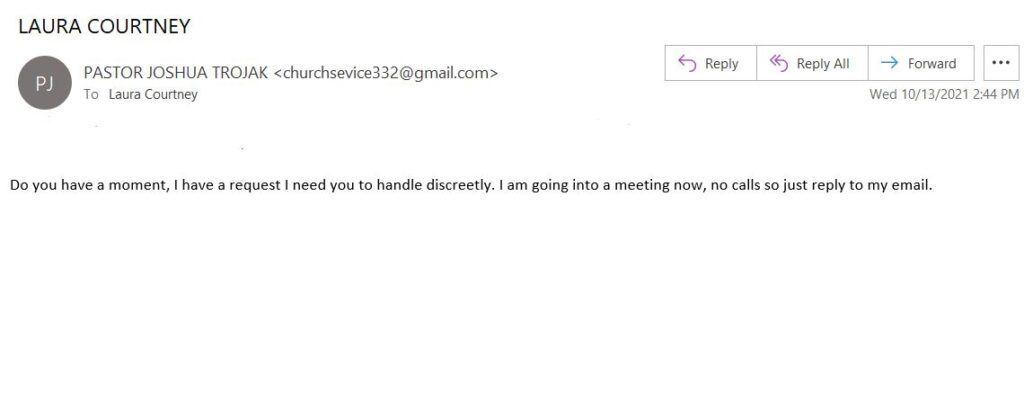by Laura Courtney
This is a bit longer than our typical “quick help” post on tech related issues, but it is one that undoubtedly one that every person reading this has encountered. There are estimated 122.3 billion spam emails distributed every day. Many of these are very obvious, but others can be a little more thought out.
Staff at CABC recently had a sneakier spammer contact several of us which made us think it might be a good time for such a topic. In this instance we’ll give our spammer a little credit since they did their research and tried to take a familiar name for staff (aka Pastor Josh) and then sent the below message to the staff email addresses posted on our website to try to solicit fraudulent payment. (Get thee behind me Satan!)
So here a just a few pointers to check if you are wondering if an email is spam or not:
- Sender email. As with our example (see image above), the spammer tried to use the name of someone we’d recognize or deem credible (aka Pastor Josh). However, if you look at the email address associated with the name, while better thought out by our spammer in order to look more credible, it is not a correct email of Pastor Josh. If you don’t see an email address listed immediately in the email, you can usually hover over the sender’s name and a contact box will pop open with the full “from” email address. This is always the quickest way to spot a spammer.
- Other contact. Again with our example, the spammer was specific in stating it could only be email contact. However, if you are suspicious that an email is spam and definitely if you know the sender name, reach out the them by another means of communication (phone number, Messenger app, etc.). This is of course the easiest way to confirm if any email is legitimate.
- Link address. Often spammers send emails telling you to sign in or click on a link. Number one rule if you think anything is ever spam is don’t click on links. (But you already knew that because you so smart!)
Opening or even replying to an email does not mean you will be hacked or that you’ve lost your persona info already (that is a common misconception though). However, if you click on a link that is fraudulent and proceed to enter login details, personal info or payment info, this is where you run into hacking and identity theft issues.
If you ever see a link in an email you suspect is fraudulent, hover your cursor over the link. The full HTML or web address can then be seen either in a temporary pop-up window or at the bottom left corner of your screen. If the web address is anything that does not make sense or does not match to the business it is referring to (e.g. if the email says its from CABC, but when you hover over the links within the email and they read something other than www.christabc.org) there is a good chance it is a spam link.
- Check the link. If all else fails and you still aren’t sure if a link is spam or not there are several web resources you can check the links or emails against. Norton Safe Web, ScanURL, Google Transparency Report, and URLVoid are just to list a few. Again, make sure you’re not clicking the link but instead just copying the text from the email itself. Having security software on your tech devices is also always encouraged. Basic free versions are available and more robust versions can be purchased with a relatively minimal monthly or yearly cost.
Hope this was helpful and if you have any follow up questions feel free to comment here, on our social media, or by email (so long as you’re not a spammer 


